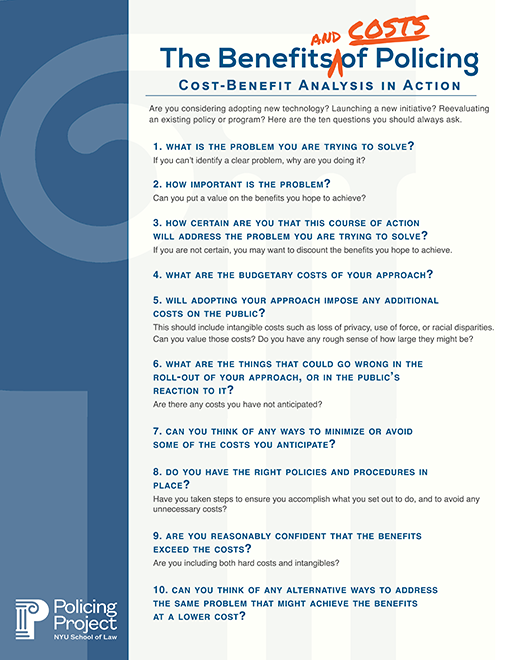CBA In Action: 10 Questions to Ask
Cost-benefit analysis sometimes involves rigorous social science research—but it need not. An essential first step is simply to list the costs and benefits of a particular technology or practice, consider the possible alternatives, and identify the policies that must be put in place in order to achieve the maximum benefit while minimizing any attendant costs.
Our “Cost-Benefit Analysis in Action” worksheet breaks down the analysis into ten questions that can help policymakers, police departments, and communities make more informed decisions about how policing occurs.
Are you considering adopting new technology? Launching a new initiative? Reevaluating an existing policy or program? Here are the ten questions you should always ask.
1. What is the problem you are trying to solve? If you can’t identify a clear problem, why are you doing it?
2. How important is that problem? Can you put a value on the benefits you hope to achieve?
3. How certain are you that this course of action will address the problem you are trying to solve? If you are not certain, you may want to discount the benefits you hope to achieve.
4. What are the budgetary costs of your approach?
5. Will adopting your approach impose any additional costs on the public, including intangible costs such as loss of privacy, use of force, or racial disparities? Can you value those costs? Do you have any rough sense of how large they might be?
6. What are the things that could go wrong in the roll-out of your approach, or in the public’s reaction to it? Are there any costs you have not anticipated?
7. Can you think of any ways to minimize or avoid some of the costs you anticipate?
8. Do you have the right policies and procedures in place to ensure sure you accomplish what you set out to do, and to avoid any unnecessary costs?
9. Are you reasonably confident that the benefits exceed the costs? Are you including both hard costs and intangibles?
10. Can you think of any alternative ways to address the same problem that might achieve the benefits at a lower cost?


